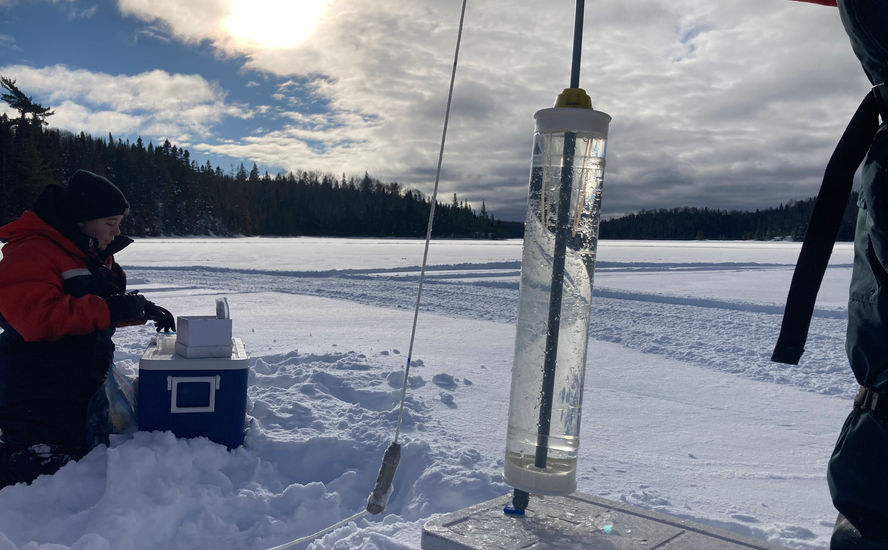
Jean-Simon Boulianne
MSc student

Winter-active plankton community in a boreal lake
A high-resolution study of seasonal and vertical abundance patterns
At the end of my biology BSc here in UQAC, I was already working in Milla’s lab on a project about winter ecology of boreal lakes, which became my MSc project. I was always interested in lake ecology and physical limnology and I developed a special interest for freshwater plankton after seeing them through the microscope. The diversity of life cycles, metabolism, body shapes and behavior caused my interest to increase and helped me understand the trophic relevance of different planktonic groups. My research is focusing on organisms from bacteria (~ 1 μm) to large zooplankton (> 1 mm) and include decomposers, primary producers and various consumers, all of which contribute to transfer of chemical energy towards the upper food web. Many species have adapted to harsh conditions, such a hypoxia or low temperatures. These conditions happen every year in Québec, during the winter. While doing my research, I saw a wide diversity and high abundance of winter active planktonic organisms. These observations challenge the classical view of winter as a season of dormancy.
Although nearly half of the world’s lakes freeze annually, winter is still rarely included in seasonal studies. More than six million lakes are present on the Canadian territory and all of them are covered in ice during winter. Knowledge about winter ecology of planktonic organisms in boreal lakes is growing, but high temporal and spatial resolution studies are still rare.
A frozen surface prevents gas exchange with the atmosphere and can block up to 100% of incoming solar radiation. These physical processes have cascading effects on the overwintering planktonic food web. The most striking difference between summer and winter is the steep reduction in light availability under a cover of ice and snow. The classical food web is fueled by sunlight, which is converted in chemical energy by primary producers. These photosynthetic organisms then provide energy and carbon to higher trophic levels. This classical energy pathway is disrupted during winter as heterotrophy becomes more prevalent.
My project aims to study zooplankton community structure and interactions, and the biomass of bacterioplankton, picoplankton, nanoflagellate and zooplankton including how they are enabled and driven by changing biogeochemistry and hydrodynamics during winter.
White light microscopy is used to identify and count zooplankton organisms in my samples. Many species of rotifers, cladocerans and copepods were observed throughout winter and at various depths. Using epifluorescence microscopy, it’s possible to differenciate between pigmented and heterotrophic nanoflagellates. The pigments contained in the photosynthetically active cells emit fluorescence when excited with UV light, wheras the heterotrophic cells can only be seen when they are stained with DAPI, a fluorescent compound that binds strongly to the DNA. The ratio of pigmented (PNF) and heterotrophic nanoflagellates (HNF) can then be used as a proxy to study the energy transfers at the base of the food web.
We sampled lake Simoncouche (Saguenay, Québec) six times between November and April to include early, mid- and late winter, as well as fall and spring overturns. Zooplankton and ancillary samples including chlorophyll-a were collected at five depths, while temperature and oxygen gradients were obtained from high frequency profiling.
Results show seasonal and vertical heterogeneity in the winter-active plankton community structure, following the shifting water column stratification, resource availability and biological adaptations. A large diversity of plankton taxa was observed in the water column throughout winter, with species of rotifers, cladocerans and copepods sustaining considerable egg production under ice. Heterotrophy became the main energy pathway and planktonic biomass was higher towards the hypolimnion, where a lateral flow from the littoral brought oxygenated water. Copepod larvae were very abundant near this flow in late winter and the overall biological activity increased in the water column before ice-off. HNF biomass increased considerably under the ice in early spring, while PNF followed similar proliferation but to a lesser degree. This study demonstrates that winter is an important season in lake ecology.
Jean-Simon finished his master in 2024. Before doing a master with Doctor Rautio, Jean-Simon did his bachelor also in UQAC. He worked in the aquatic laboratory during is bachelor and did his final undergraduated project within the lab as well. He went on multiple field work to either help other student or for is own project during the summer as well as winter. Which made him gain a lot of field experience !
Email :
Below you can read a resume of his studies and also see photos from the field.













